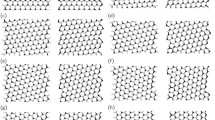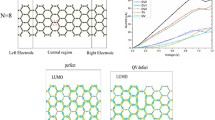Abstract
In recent years, two-dimensional materials (2DM) (such as HfSe2) have demonstrated various outstanding properties that make them superior to their bulk structures. In this work, first-principles calculations are used to study the electronic and electrical behaviors of pure and defective HfSe2 nanoribbons. The results show that the zigzag nanoribbon with six atoms across the edge (6ZHfSeNR) is metallic. At the same time, the armchair nanoribbon (6AHfSeNR) is energetically more stable and shows semiconducting properties with various edge passivations (passivating the edges with hydrogen and oxygen atoms). In addition, we apply different vacancy defects to both pure structures (without edge) to evaluate both the electronic and electrical behaviors of these nanoribbons in the presence of such vacancy defects. The calculated data illustrate that applying different atoms at the edge and removing other atoms to make defects have a significant influence on the behavior of pure structures. The results show that all zigzag structures consisting of edge passivated and defective ones behave as metal. Moreover; in the armchair case, the 6AHfSeNR, 6AHfSeNR-1Se, 6AHfSeNR-2Se-2, and 6AHfSeNR-H are semiconductors.
Graphical Abstract







Similar content being viewed by others
Data Availability
Data sharing is not applicable to this article as no datasets were generated or analyzed during the current study.
Change history
30 November 2023
A Correction to this paper has been published: https://doi.org/10.1007/s11664-023-10854-4
References
K.S. Novoselov, A. Mishchenko, A. Carvalho, and A.H. Castro-Neto, 2D materials and van der Waals heterostructures. Science 353(62), 9439 (2016). https://doi.org/10.1126/science.aac9439.
T. Kolobov, Two-Dimensional Transition-Metal Dichalcogenides (Singapore: Springer, 2016).
K.S. Novoselov, D. Jiang, F. Schedin, T. Booth, V.V. Khotkevich, S.V. Morozov, and A.K. Geim, Two-dimensional atomic crystals. Proc. Natl. Acad. Sci. USA 102, 10451–10453 (2005).
C. Lee, Q. Li, W. Kalb, X.-Z. Liu, H. Berger, R.W. Carpick, and J. Hone, Frictional characteristics of atomically thin sheets. Science 328, 76–80 (2010).
X. Zhao, C. Xia, T. Wang, Y. Peng, and X. Dai, Effective p-type N-doped WS2 monolayer. J. Alloy. Compd. 649, 357 (2015). https://doi.org/10.1016/j.jallcom.2015.07.153.
S. Yang, C. Wang, H. Sahin, H. Chen, Y. Li, S. Li, A. Suslu, F. Peeters, Q. Liu, J. Li, and S. Tongay, Tuning the optical, magnetic, and electrical properties of ReSe2 by nanoscale strain engineering. Nano Lett. 15, 1660 (2015). https://doi.org/10.1021/nl504276u.
X. Fang, C. Hua, X. Guo, Y. Hu, Z. Wang, X. Gao, F. Wu, J. Wang, and L. Chen, Lithium storage in commercial MoS2 in different potential ranges. Electrochim. Acta 81, 155 (2013).
G. Du, Z. Guo, S. Wang, R. Zeng, Z. Chen, and H. Liu, Superior stability and high capacity of restacked molybdenum disulfide as anode material for lithium ion batteries. Chem. Commun. 46, 1106 (2010). https://doi.org/10.1039/B920277C.
G. Eda, H. Yamaguchi, D. Voiry, T. Fujita, M.W. Chen, and M. Chhowalla, Photoluminescence from chemically exfoliated MoS2. Nano Lett. 11, 5111 (2011). https://doi.org/10.1021/nl201874w.
S. Tongay, H. Sahin, C. Ko, A. Luce, W. Fan, K. Liu, J. Zhou, Y.S. Huang, C.H. Ho, J. Yan, D.F. Ogletree, S. Aloni, J. Ji, S.S. Li, J. Li, F.M. Peeters, and J. Wu, Monolayer behaviour in bulk ReS2 due to electronic and vibrational decoupling. Nat. Commun. 5, 3252 (2014). https://doi.org/10.1038/ncomms4252.
J. Kang, J. Li, S.S. Li, J.B. Xia, and L.-W. Wang, Electronic structural Moiré pattern effects on MoS2/MoSe2 2D heterostructures. Nano Lett. 13, 5485 (2013). https://doi.org/10.1021/nl4030648.
M. Thomalla and H. Tributsch, Photosensitization of nanostructured TiO2 with WS2 quantum sheets. J. Phys. Chem. B 110, 12167 (2006). https://doi.org/10.1021/jp061371q.
R.L. Withers and J.W. Steeds, Diffraction and imaging studies of the charge-density-wave-modulated phases of 1T-TaS2. J. Phys. C 20, 4019 (1987). https://doi.org/10.1088/0022-3719/20/26/008.
R. Manzke, M. Skibowski, edited by A. Goldmann, Electronic Structure of Solids: Photoemission Spectra and Related Data Subvolume B, Landolt-Börnstein, New (1994). https://doi.org/10.1007/b91258.
A. Hussain Reshak and S. Auluck, Ab initio calculations of the electronic and optical properties of 1T-HfX2 compounds. Phys. B Condens. Matter. 363(14), 25 (2005). https://doi.org/10.1016/j.physb.2005.02.030.
H. Jiang, Structural and electronic properties of ZrX2 and HfX2 (X _ S and Se) from first principles calculations. J. Chem. Phys. 134(20), 204705 (2011). https://doi.org/10.1063/1.3594205.
M. Salavati, Electronic and mechanical responses of two-dimensional HfS2, HfSe2, ZrS2, and ZrSe2 from first-principles. Front. Struct. Civ. Eng. 13(2), 486 (2018). https://doi.org/10.1007/s11709-018-0491-5.
C. Cheng, J.-T. Sun, X.-R. Chen, and S. Meng, Hidden spin polarization in the 1 T -phase layered transition-metal dichalcogenides MX 2 (M_ Zr, Hf; X _S, Se, Te). Sci. Bull. 63(2), 85–91 (2018). https://doi.org/10.1016/j.scib.2017.12.003.
Q. Zhao, Y. Guo, K. Si, Z. Ren, J. Bai, and X. Xu, Elastic, electronic, and dielectric properties of bulk and monolayer ZrS2, ZrSe2, HfS2, HfSe2 from van der Waals density-functional theory. Phys. Status Solidi 254(9), 1700033 (2017). https://doi.org/10.1002/pssb.201700033.
I. Setiyawati, K.R. Chiang, H.M. Ho, and Y.H. Tang, Distinct electronic and transport properties between 1T-HfSe2 and 1T-PtSe2. Chin. J. Phys. 62, 151 (2019). https://doi.org/10.1016/j.cjph.2019.09.029.
W.S. Yun, S.W. Han, S.C. Hong, I.G. Kim, and J.D. Lee, Thickness and strain effects on electronic structures of transition metal dichalcogenides: 2H-MX2 semiconductors (M _ Mo, W; X _ S, Se, Te). Phys. Rev. B 85(3), 033305 (2012). https://doi.org/10.1103/physrevb.85.033305.
T.M.D. Huynh, D.K. Nguyen, T.D.H. Nguyen, V.K. Dien, H.D. Pham, and M.F. Lin, Geometric and electronic properties of monolayer HfX2 (X _ S, Se, or Te): a first-principles calculation. Front. Mater. 7, 569756 (2021). https://doi.org/10.3389/fmats.2020.569756.
P. Hohenberg and W. Kohn, Inhomogeneous electron gas. Phys. Rev. 136(3B), B864 (1964). https://doi.org/10.1103/physrev.136.b864.
J.P. Perdew and Y. Wang, Erratum: accurate and simple analytic representation of the electron-gas correlation energy. Phys. Rev. B 98(7), 079904 (2018). https://doi.org/10.1103/physrevb.98.079904.
M. Ernzerhof and G.E. Scuseria, Assessment of the Perdew–Burke–Ernzerhof exchange-correlation functional. J. Chem. Phys. 110(11), 5029 (1999). https://doi.org/10.1063/1.478401.
S. Jamalzadeh Kheirabadi, F. Behzadi, and M. Sanaee, The effect of edge passivation with different atoms on ZrSe2 nanoribbons. Sens. Actuators Phys. 317, 112471 (2021). https://doi.org/10.1016/j.sna.2020.112471.
E. Unsal, R.T. Senger, and H. Sevinçli, Enhancement of thermoelectric efficiency of T-HfSe2 via nanostructuring. Phys. Rev. B 103, 014104 (2021). https://doi.org/10.1103/PhysRevB.103.014104.
Author information
Authors and Affiliations
Contributions
All authors contributed to the study conception and design. Material preparation, data collection, and analysis were performed by Mazdak Ghaedsharafi, Mohammad Reza Moslemi, and Farshad Pesaran. The first draft of the manuscript was written by Mazdak Ghaedsharafi, and all authors commented on previous versions of the manuscript. All authors read and approved the final manuscript.
Corresponding author
Ethics declarations
Conflict of interest
On behalf of all authors, the corresponding author states that there is no conflict of interest.
Additional information
Publisher's Note
Springer Nature remains neutral with regard to jurisdictional claims in published maps and institutional affiliations.
The original online version of this article was revised: The authors’ complete affiliations were added.
Rights and permissions
Springer Nature or its licensor (e.g. a society or other partner) holds exclusive rights to this article under a publishing agreement with the author(s) or other rightsholder(s); author self-archiving of the accepted manuscript version of this article is solely governed by the terms of such publishing agreement and applicable law.
About this article
Cite this article
Ghaedsharafi, M., Moslemi, M.R. & Pesaran, F. The Influence of Edge Atoms and Vacancy Defects on Different Types of HfSe2 Nanoribbons. J. Electron. Mater. 53, 969–978 (2024). https://doi.org/10.1007/s11664-023-10787-y
Received:
Accepted:
Published:
Issue Date:
DOI: https://doi.org/10.1007/s11664-023-10787-y




